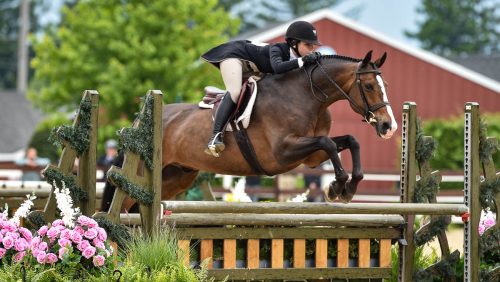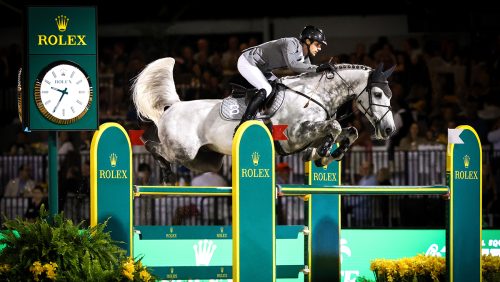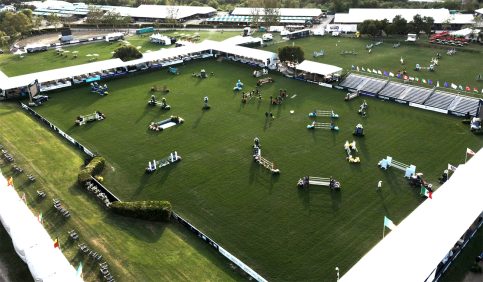In the latest of a series of webinars being held to update members on the work of the recently repopulated U.S. Equestrian Federation Competition Task Force, USEF President Tom O’Mara and CEO Bill Moroney on Sept. 21 outlined the most recent proposals developed for hunter/jumper competitions. The proposals are designed to address five main priorities identified by members: safety, fairness and enjoyment; accessibility; quality competitions; meaningful recognition; and simplifying the sport.
Once finalized by the task force, the proposals will be presented for a vote at the USEF board of directors’ November meeting. If approved, the changes would go into effect for the 2023 show season, which begins Dec. 1, 2022, as some licenses for the 2022 season have been granted already.
Here are the top takeaways from the most recent webinar:
Prize money rules are still in the works.
The task force is continuing its work on suggested changes to prize money requirements for hunter/jumper competitions at all levels (premier, national and regional). The group has modified a proposal that initially would have allowed regional competitions to offer up to $50,000 in prize money with no minimum. After more discussion, the task force has proposed lowering the maximum prize money offered to $24,999.
“It’s finding the balance between what encourages more development and people being able to be more flexible in what they’re offering, but at the same time, doesn’t create an environment where we reduce accessibility due to affordability,” Moroney said. “So the task force looked this over and felt it was better to maybe to start a little softer with a limit of $24,999 in the regional competitions and be able to monitor that and increase than it would be to start big and potentially have to go backward.”
Building on a previous recommendation that show management be required to pay out a minimum of 80% of the prize money offered even if all sections do not fill, the task force has provided further clarification to how hunter prize money should be paid:
• If management offers prize money in a hunter section, it cannot be decreased if the section fills and is held. This applies not only to the total prize money offered but also the payout per class and per placing in each class.
ADVERTISEMENT
• If hunter prize money is not paid because a hunter section was offered but not held, that prize money may be reallocated to another rated section that has not been held yet. For example, if a show’s high-performance hunters do not fill on Wednesday, that prize money may be reallocated to a junior hunter division happening Friday.
• If prize money is reallocated to another division, the entry fee for that division may not be increased.
Guidelines have been added for shows that utilize USEF Horse of the Year points for qualification.
In July, the task force proposed creating two different channels for Horse of the Year points and money-won standings. On the hunter side, points/money earned at premier and national shows would go to “Channel I” standings, while those earned at regional shows would go to “Channel II” standings. For jumpers, placings earned at jumper level 1-6 competitions held in conjunction with a premier or national show or a standalone level 4-6 competition would go towards Channel I, while placings at jumper level 1-3 competitions held either in conjunction with a regional show or as a standalone event would go towards Channel II standings.
Originally, the task force suggested shows that utilize USEF HOTY standings for qualifications (i.e. Devon Horse Show [Pennsylvania] and the indoor shows) be allowed to choose which channel they would use for qualification purposes. Further feedback from members prompted the task force to set parameters for these shows.
The task force now is proposing the following shows should use Channel I standings for qualification purposes:
• Premier- or national-rated competitions held in conjunction with a jumper level 1-6 competition
• Standalone premier- or national-rated hunter competitions
• Standalone jumper level 4-6 competitions
The task force now is proposing the following shows should use Channel II standings for qualification purposes:
ADVERTISEMENT
• Regional hunter competitions held in conjunction with a jumper level 1-3 competition
• Standalone regional-rated hunter competitions
• Standalone jumper level 1-3 competitions
Qualification for major equitation events (USEF Medal Final, ASPCA Maclay, etc.) would be left up to the event holder. However, most of these competitions already have their own qualification criteria separate from HOTY standings.
Combining and dividing rules for national and regional competitions got an upgrade.
While rules for combining and dividing sections remain unchanged for premier-rated competitions, the task force is proposing a change for national and regional shows that would allow organizers to offer combined sections from the start.
Using the junior hunter division as an example, premier-rated shows must offer all four sections of the junior hunters, and they can be combined if a section doesn’t fill. But because there’s such a vast number of national and regional shows with diverse clientele, Moroney said the task force decided to allow managers to offer a single “junior hunter” section in the prize list.
If there are enough entries to warrant separate sections, managers must split the sections and award appropriate prize money for each section, class and placing. For example, if a show offers a $1,000 junior hunter section with $200 awarded in each class and $100 of that awarded to first place, if the section is divided, each section must pay out $1,000, $200 and $100, respectively. The entry fee cannot be altered from what was printed in the prize list.
The prize money requirement hasn’t changed from what is currently in the USEF Rule Book, but the language is changing to make things clearer, Moroney said.
These proposed changes will be available for member comment and may be altered before they are presented to the USEF board in November.














